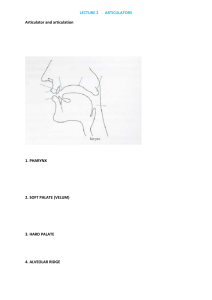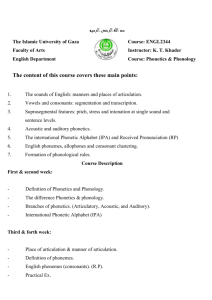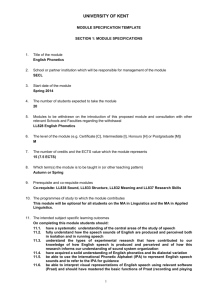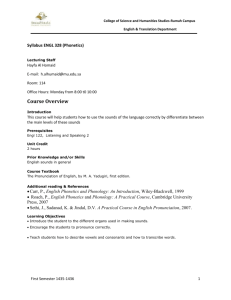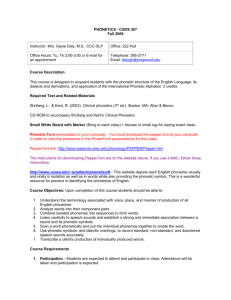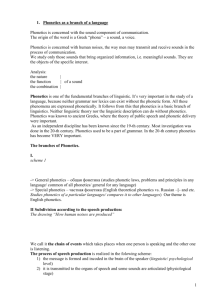texts phonetic
advertisement
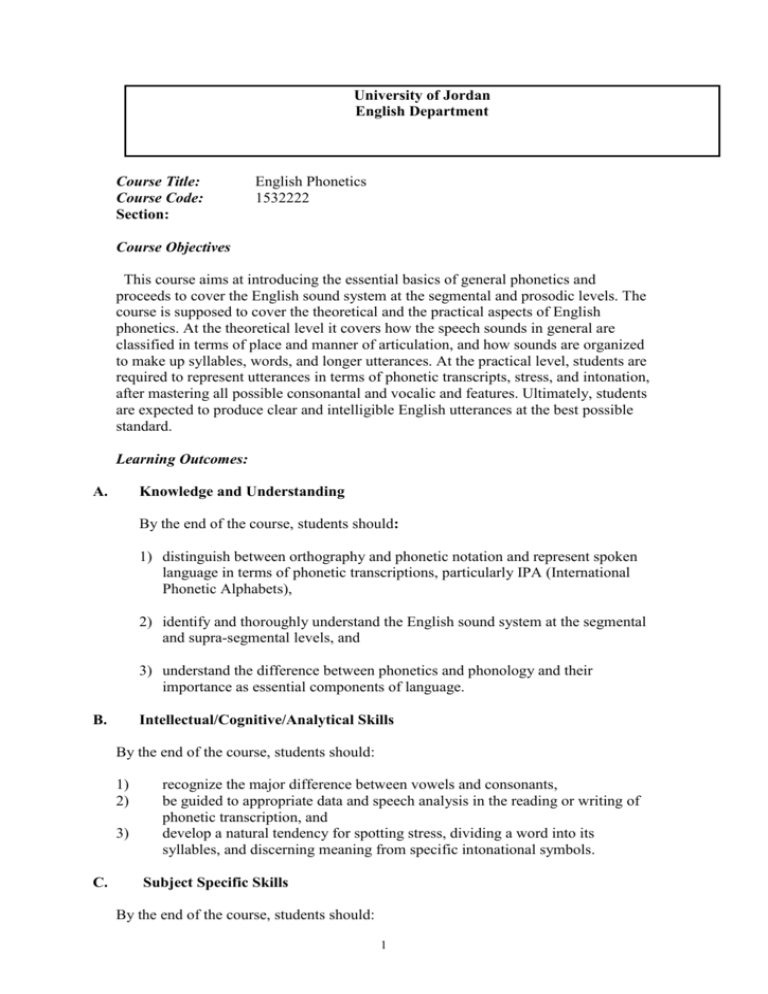
University of Jordan English Department Course Title: Course Code: Section: English Phonetics 1532222 Course Objectives This course aims at introducing the essential basics of general phonetics and proceeds to cover the English sound system at the segmental and prosodic levels. The course is supposed to cover the theoretical and the practical aspects of English phonetics. At the theoretical level it covers how the speech sounds in general are classified in terms of place and manner of articulation, and how sounds are organized to make up syllables, words, and longer utterances. At the practical level, students are required to represent utterances in terms of phonetic transcripts, stress, and intonation, after mastering all possible consonantal and vocalic and features. Ultimately, students are expected to produce clear and intelligible English utterances at the best possible standard. Learning Outcomes: A. Knowledge and Understanding By the end of the course, students should: 1) distinguish between orthography and phonetic notation and represent spoken language in terms of phonetic transcriptions, particularly IPA (International Phonetic Alphabets), 2) identify and thoroughly understand the English sound system at the segmental and supra-segmental levels, and 3) understand the difference between phonetics and phonology and their importance as essential components of language. B. Intellectual/Cognitive/Analytical Skills By the end of the course, students should: 1) 2) 3) C. recognize the major difference between vowels and consonants, be guided to appropriate data and speech analysis in the reading or writing of phonetic transcription, and develop a natural tendency for spotting stress, dividing a word into its syllables, and discerning meaning from specific intonational symbols. Subject Specific Skills By the end of the course, students should: 1 1) 2) D. produce English utterances as natively as possible provided they are consistent in the accent they chose to acquire, and recognize the conventional approach to English phonetics in the description of English monophthongs, diphthongs, triphthongs, and consonants. Transferable Skills By the end of the course, students should: 1) 2) 3) develop better oral skills through class discussions and some special home assignments, improve their analytical and critical thinking skills through the development of well thought-out arguments pertaining to some aspects of linguistic theorizing, and develop technical preparation strategies through which they become active participants in class discussions rather than passive recipients. Teaching Methods: 1. Lectures: three hours per week (All learning outcomes) 2. Assignments: the students know they have to prepare by reading the text books in advance and note their questions to be discussed in class (outcome D) 3. Audio Materials: students would listen to recorded samples of English utterances and attempt to provide the appropriate phonetic transcriptions. They are also required to transcribe given texts and read phonetically transcribed texts (outcomes A, B, and C). Course Plan WEEK TOPIC 1 Chapter 1: Introduction 2 Chap 2: The production of speech sounds 3 Chapter 3: Long vowels, diphthongs and triphthongs 4 Chapter 4: Voicing and consonants 5 Chapter 5: The phoneme 6 Chapter 6: Fricatives and affricates 7 Chapter 7: Nasals and other consonants 8 Chapter 8: the Syllable 9 Chapter 9: Strong and weak syllables 10 Chapter 10: Stress in simple words 11 Chapter 11: Complex word stress 12 Chapter 12: Weak forms 13 Chapter 13: Problems in phonemic analysis Chapter 14: Aspects of connected speech 2 14 Chapter 15: Intonation 1 Chapter 16: Intonation 2 15 Chapter 17: Intonation 3 Chapter 18: Functions of intonation 1 16 Revision Textbook: Roach, Peter. English Phonetics and Phonology: a Practical Course. Cambridge University Press, 2002. (With 2 audio-cassettes). References: - Carr, Philip. English Phonetics and Phonology: An Introduction. Blackwell Publishers, 1999. Massachusetts: - Davenport, M., and S. J. Hannahs. Introducing Phonetics and Phonology. London: Arnold, 1998. - Edwards, H. Applied Phonetics (2nd ed.). Singular Publishing Group. 1977. - Gimson. An Introduction to The Pronunciation of English. Arnold. 1984. - Hornby, A. S., A. P. Cowie, and A. C. Gimson. Oxford Advanced Learner's Dictionary of Current English. Oxford: Oxford UP. 1974. (or any British monolingual dictionary). English - Jones. D. An Outline of English Phonetics. Cambridge UP, 1989. - Ladefoged, P. A Course in Phonetics. Heinle and Heinle. 2001. - O’ Connor, J. D. Better English Pronunciation. ( new edition). Cambridge: Cambridge University Press. - Salah, G., and H. Tushyeh. English Phonetics. 1986. Participation and attendance: Participation in class is essential. Students are expected to participate actively. Regular attendance is essential as well. Assessment 1. 2. Mid-term Class work - Quiz - Assignments - Participation 30% 10% 5% 5% 3 3. Final Exam 50% 4



